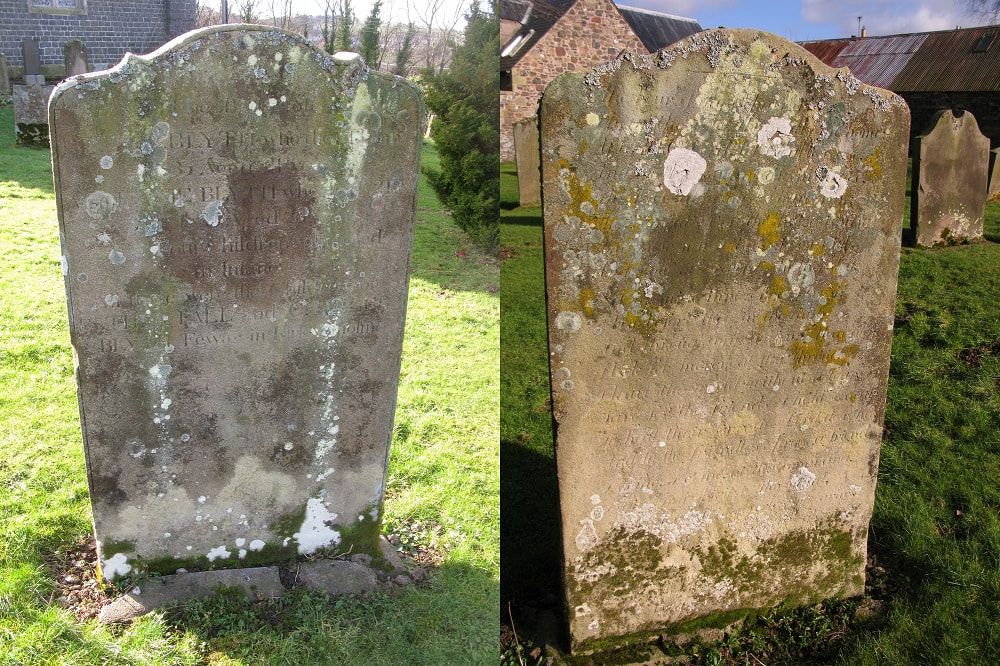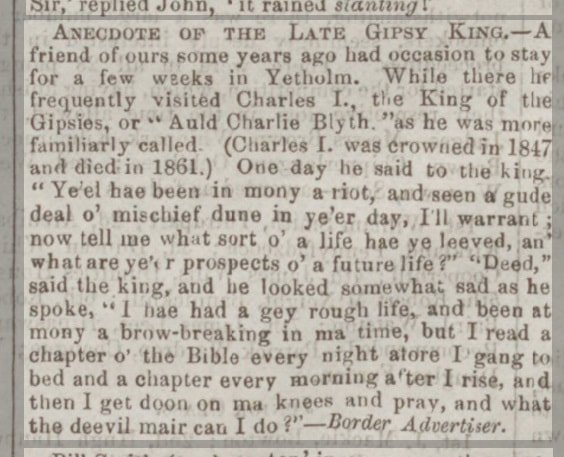|
There are only three gravestones associated with the Blythe family in Yetholm Kirkyard. Two of the stones were erected by Andrew Richardson Blythe, the nephew of King Charles Blythe (1775-1861), who eschewed the gipsy lifestyle and worked as a teacher in the Coquet valley for over 50 years – see A Life Illumined by Graeme Watson - more info HERE. The third gravestone is not that of the king himself, but commemorates some of his children. The face of the stone reads:
Here lies the body of BETTY BLYTHE who died 13.1.1835 aged 21 years and JEANIE BLYTHE who died 21.1.1835 aged 23 years and four children who died in infancy all these were the children of ESTHER FAA and CHARLES BLYTHE fewar in Kirk-Yetholm. The two young women died within days of each other, although we don’t know the cause – Diphtheria? Cholera? The stone itself is quite large and elegant. Given that King Charles died as a pauper (he was put on the parish poor-roll in about 1843, four years before his coronation in 1847) one wonders where the money came from to design and buy such a memorial? According to the transcription of the text on the gravestone in the guide published by the Borders Family History Society the text on the reverse is illegible. It is certainly very hard to read, but it is possible to do so and it turns out to be a hymn - a relatively unusual touch on local graves - which is given at some length. This is what is written - THE hour of my departure's come, I hear the voice that calls me home; At last, O Lord, let trouble cease, And let thy servant die in peace! The race appointed I have run; The combat’s o’er, the prize is won; And now my witness is on high, And now my record’s in the sky. Not in mine innocence I trust; I bow before thee in the dust, And through my Saviour's blood alone I look for mercy at thy throne. I leave the world without a tear, Save for the friends I held so dear; To heal their sorrows, Lord, descend, And to the friendless prove a friend! I come, I come at thy command, I yield my spirit to thy hand! Stretch forth thy everlasting arms, And shield me in the last alarms. There is little to suggest that King Charles was a church-going man. Other members of the Blythe family were baptised in the Anglican church in Carham – perhaps a nod to the family’s English origins – but none of his many children seem to have been baptised anywhere. True, an interview with him published in 1862, a year after his death, suggests a degree of non-institutional piety: ANECDOTE OF THE LATE GIPSY KING.—A friend of ours some years ago had occasion to stay for a few weeks in Yetholm. While there he frequently visited Charles 1, the King of the Gipsies, or “Auld Charlie Blyth" as he was more familiarly called. (Charles I was crowned in 1847 and died in 1861) One day he said to the king. " Ye'el hae been in mony a riot, and seen a gude deal o' mischief dune in ye'er day, I’ll warrant ; now tell me what sort o' a life hae ye leeved, an' what are ye', r prospects o' a future life ?" "Deed," said the king, and he looked somewhat sad as he spoke, "I hae had a gey rough life, and been at mony a brow-breaking in ma time, but I read a chapter o' the Bible every night afore I gang to bed and a chapter every morning a'ter I rise, and then I get doon on ma knees and pray, and what the deevil mair can I do?"—Border Advertiser. Ardrossan and Saltcoats Herald - Saturday 18 January 1862 - reproduced below. Perhaps, then, the king himself chose the hymn on the gravestone - ? An alternative possibility is that the choice of text was made by another member of the family. William Brockie in his book about the Yetholm gipsies quotes some intriguing reminiscences of Charles Blythe in his prime by James Buchan, who emigrated to America in about 1836, but who returned for a visit to the Borders in 1871/2 (see letter in Kelso Chronicle, Friday 12th July 1872). Buchan adds: One of Charlie’s sons ‘oor Tam’ learned the trade of stone mason, and, not fancying the Gypsy way of living nor his paternal surroundings, as soon as his apprenticeship expired left the Borders to seek his fortune in England. In the course of a few years thereafter, hearing of the success of ‘oor Tam’, old Charlie made a visit to Halifax, where his son was married and settled down in life as an industrious mechanic. It appears Tam had joined the Methodists in that flourishing town, and in recognition of his zeal and ability, he became in time a class leader among the disciples of John Wesley. On his return to his native village, Charlie was very eloquent about his son and his position in Halifax. He loved to dwell on Tam’s altered position, and informed his friends and neighbours ‘that oor Tam was a godfaither noo, and could preach as weel as Maister Blaikie’ (the Kirk minister). William Brockie, The Gypsies of Yetholm, 1884, page 134 The hymn ‘The Hour of my Departure’s Come’ may be the work of the Scottish weaver-poet Michael Bruce, subsequently appropriated by John Logan. It was published in Scottish Translations and Paraphrases, 1781. However, it was also published in Methodist hymn books and sometimes attributed to Charles Wesley. Could Tam Blythe have suggested the text to his father – and perhaps even have carved the stone itself? Apart from the reference to him in Brockie’s book nothing is known about Tam. He was clearly keen to turn his back on his father’s way of life, but relations between the two seem to have been friendly and Charles was proud of his son. When Charles himself died on the 19th August 1861, a pauper aged 86, his death went unremarked in the press. He was presumably buried in the kirkyard too, but no one seems to have had the money or inclination to erect a similarly impressive gravestone in honour of the gipsy king.
40 Comments
|
Archives
July 2024
|


 RSS Feed
RSS Feed
